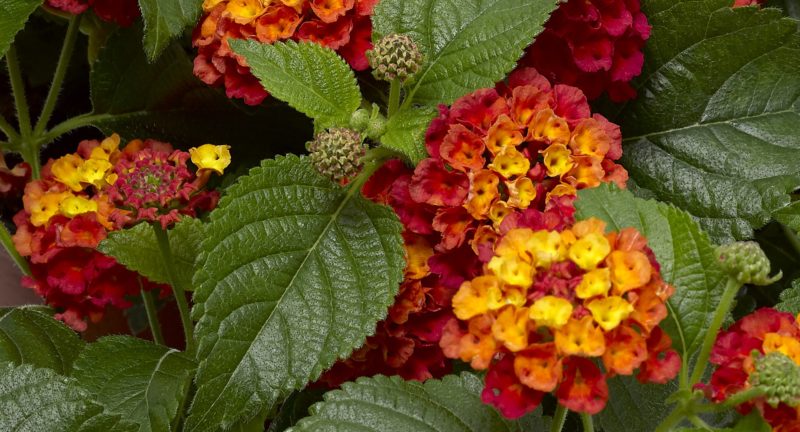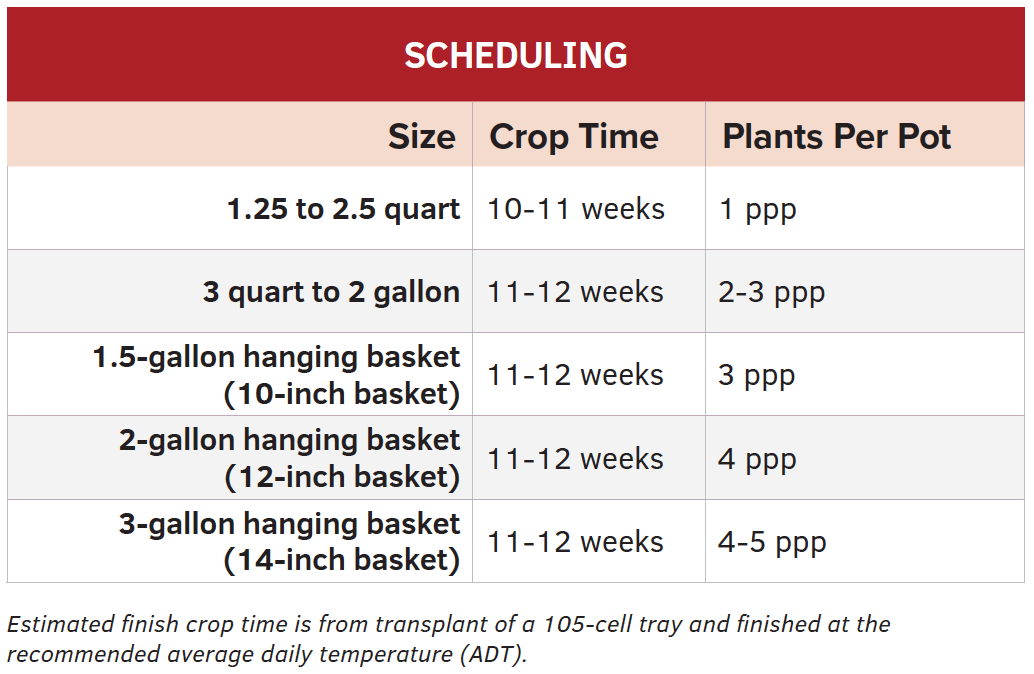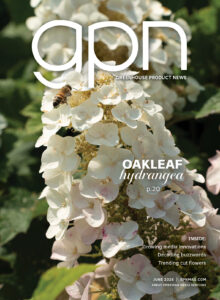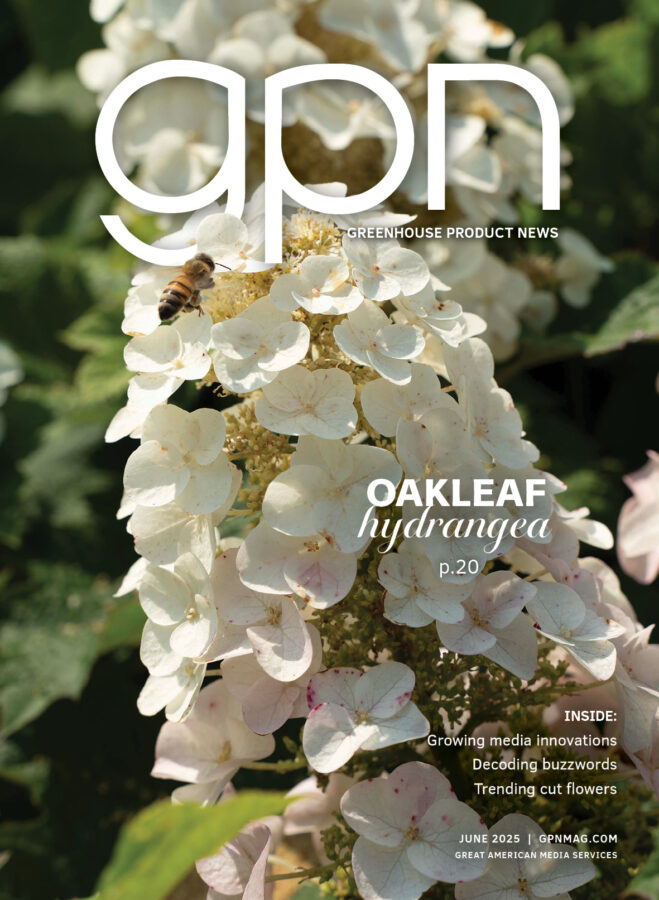
Culture Report: Bandolero Lantana Series
Bandolero lantana (Lantana camara) was bred to have large flowers and a vigorous branching habit. It’s an excellent series for large containers, premium summer combos and the landscape. It has an easy, mounded habit reaching 18 to 22 inches in height and width in the garden. Bandolero has six festive colors: Pink, Cherry Sunrise, Guava, Red, White and Pineapple. Bandolero has the same mounding habit with about 20 to 30% more vigor than Bandana, making it ideal for Northern regions that need more vigor and Southern regions that want a big, bold finish in a large container.
PROPAGATION
Be sure to prioritize sticking your lantana cuttings shortly after arrival, as they do not tolerate extensive storage time. Place shipping boxes in the cooler until ready to stick. Ideal temperatures for lantana cuttings are between 48° F and 55° F. Lantana cuttings can be damaged if stored at temperatures below 45° F. Syngenta ships each of its lantana boxes with an EthylBloc sachet inside to protect your cuttings from the harmful effects of ethylene making sure you get the highest-quality product.
Rooting hormone. Stick into a 105-cell tray or larger. Once stuck, root emergence should begin in 10 to 12 days. We recommend a 0.1% (1,000-ppm) IBA dip to the cutting stem. Be careful not to coat the leaves or entire cutting — excess application can cause burning and damage to the cutting. Another option is to apply an overhead sprench using water-soluble K-IBA to the cuttings (penetrating the rooting media) at 250 to 300 ppm 24 to 48 hours after sticking. Do not use overhead applications of alcohol-based IBA solutions. Plugs should finish in four-and-a-half to five weeks for a 105-cell tray; add more rooting time for significantly larger plug sizes.
Irrigation. Mist schedules vary depending on light and temperature conditions. Apply just enough moisture to rehydrate the cuttings and keep them from wilting. Cuttings should be hydrated and in a non-wilted stage within 24 hours after sticking. Cuttings that continue to wilt heavily after 24 hours will callus unevenly and will be delayed in rooting. CapSil (spray adjuvant) can be sprayed on the cuttings at a rate of 2 to 4 ounces/100 gallons within one to two days after sticking to help with rehydration. Misting should be significantly reduced after three to four days and after cuttings become fully hydrated. Applying too much mist early on can lead to foliar disease and tissue breakdown.
Temperature and light. Maintain media temperature at 72 to 74° F for the first three weeks. After roots are well developed, temperatures can be lowered to hold and tone the cuttings. Maintain a light intensity of 1,000 to 1,200 foot-candles (200 to 250 micro mols) for the first two weeks after sticking or until root development occurs. Light levels can be increased up to 3,000 foot candles (600 micro mols) as rooting increases and the cutting matures. If monitoring your light levels using moles, a Daily Light Integral (DLI) of 4 to 6 mols/day for the first two weeks after sticking or until root development occurs is recommended. DLI can be increased to greater than 12 mols/day after root formation.
Nutrition and growth control. Begin fertilization at 100-ppm nitrogen when roots become visible. Rates can be increased up to 200-ppm nitrogen after roots become well-developed. Use primarily Cal-Mag Plus (calcium nitrate + magnesium nitrate) fertilizers in propagation to prevent unwanted stretch. The media EC should be 1.4 to 2.0 (Pour Thru) and pH of 5.8 to 6.2. Approximately 16 to 18 days after stick, a tank-mix spray of Florel (350 ppm) + B-Nine WSG (2,500 to 3,500 ppm) is recommended to control growth and improve branching. However, do not spray Florel + B-Nine WSG tank mixes on cuttings that are stressed or under-developed. A second Florel + B-Nine WSG spray three days before transplanting can also be applied. We have seen growers have success with these two applications removing the need for a pinch post-transplant. Alternatively, a tank-mix spray of B-Nine WSG (2,500 to 3,500 ppm) + Cycocel (1,000 ppm) can also be used to control growth.

FINISHING
Bandolero is best suited for 2.5-quart containers and larger for growers in the Southern United States. In the South, where Bandolero will be most vigorous, less plants per pot can be used to fill containers than in the Northern U.S. Northern growers can utilize 1.25-quart containers for early season finishing. Transplant one plant per pot (ppp) for a 2.5 quart, three ppp for 1.5-gallon hanging baskets, and four ppp for 3-gallon hanging baskets. See Table 1 for more transplanting recommendations and their corresponding finish times. See Table 2 for an example crop schedule in a 2.5-quart container. Looking for something more compact? Consider Bandana for smaller container sizes (1 to 1.25 quart) and Bandito for packs and small pots.
Temperature and light. Grow Bandolero at day temperatures of 76 to 78° F and night temperatures of 70 to 72° F; average daily temperature (73 to 75° F). High light intensities (4,000 to 6,000 foot-candles) and DLIs of 16 to 18 mols/day help achieve optimal flowering and coloration. Relatively high light levels and warm temperatures are needed to produce high-quality plants.
Nutrition and growth control. Bandolero was bred for excellent branching and a vigorous, mounding habit. A pinch may be beneficial seven to 10 days after transplant if not well-controlled in propagation. Alternatively, an application of Florel (350 to 500 ppm) + B-Nine WSG (2,500 to 3,500 ppm) 14 days after transplant will give a similar affect and improve branching. Bandolero has the same mounding habit, with about 20 to 30% more vigor than Bandana and may need regular PGR applications to control growth. Florel sprays (350 to 500 ppm) or a tank-mix spray of Florel (350 to 500 ppm) + B-Nine WSG (2,500 to 3,500 ppm) can also be used to control growth. Note that Florel will delay flowering slightly when used later in production. Sprays of B-Nine WSG (2,500 to 3,500 ppm) + Cycocel (1,000 ppm), Sumagic (15 to 20 ppm), or Bonzi (20 to 30 ppm) are also effective. Additionally, mid-crop Bonzi drenches (2 to 4 ppm) work well to control height. Always remember that proper drench volumes are key to achieving the proper control. To reduce flower cycling, keep plants well fertilized (200 to 250 ppm nitrogen; Pour Thru EC 2.3 to 3.2) and avoid severe drought stress. Media pH should be 5.8-6.2. Bandolero has no significant disease issues. Common pests include aphids, whiteflies and leafminers.
Finishing and postharvest. For best postharvest quality, apply Chrysal Alesco as flowers first begin to open to help protect plants from ethylene build up during shipping so they have more color at retail. If two or more weeks will pass between first color and shipping, apply Alesco again one to two days before shipping for maximum protection. Also avoid stage 1 moisture levels or significant wilting during flowering to avoid excessive shatter. Maintain nutrition through finish to prolong flowering and flower color intensity. Lantana are very drought tolerant; however, keeping plants hydrated is critical for continual flowering and less cycling. Extreme moisture stress and wilting will cause flower shattering, resulting in significant lag time to the next flower flush. Adequate fertility will provide faster growth and flower bud formation reducing the lag time and cycling.
Important: Always read and follow label instructions. Some products may not be registered for sale or use in all states or counties and/or may have state-specific use requirements. Please check with your local extension service to ensure registration status and proper use. Some or all of the varieties may be protected under one or more of the following: Plant Variety Protection, United States Plant Patents and/or Utility Patents and may not be propagated or reproduced without authorization.









 Video Library
Video Library 


















